-
Defect Physics
-
Br passivating DX center in CH3NH3PbI3
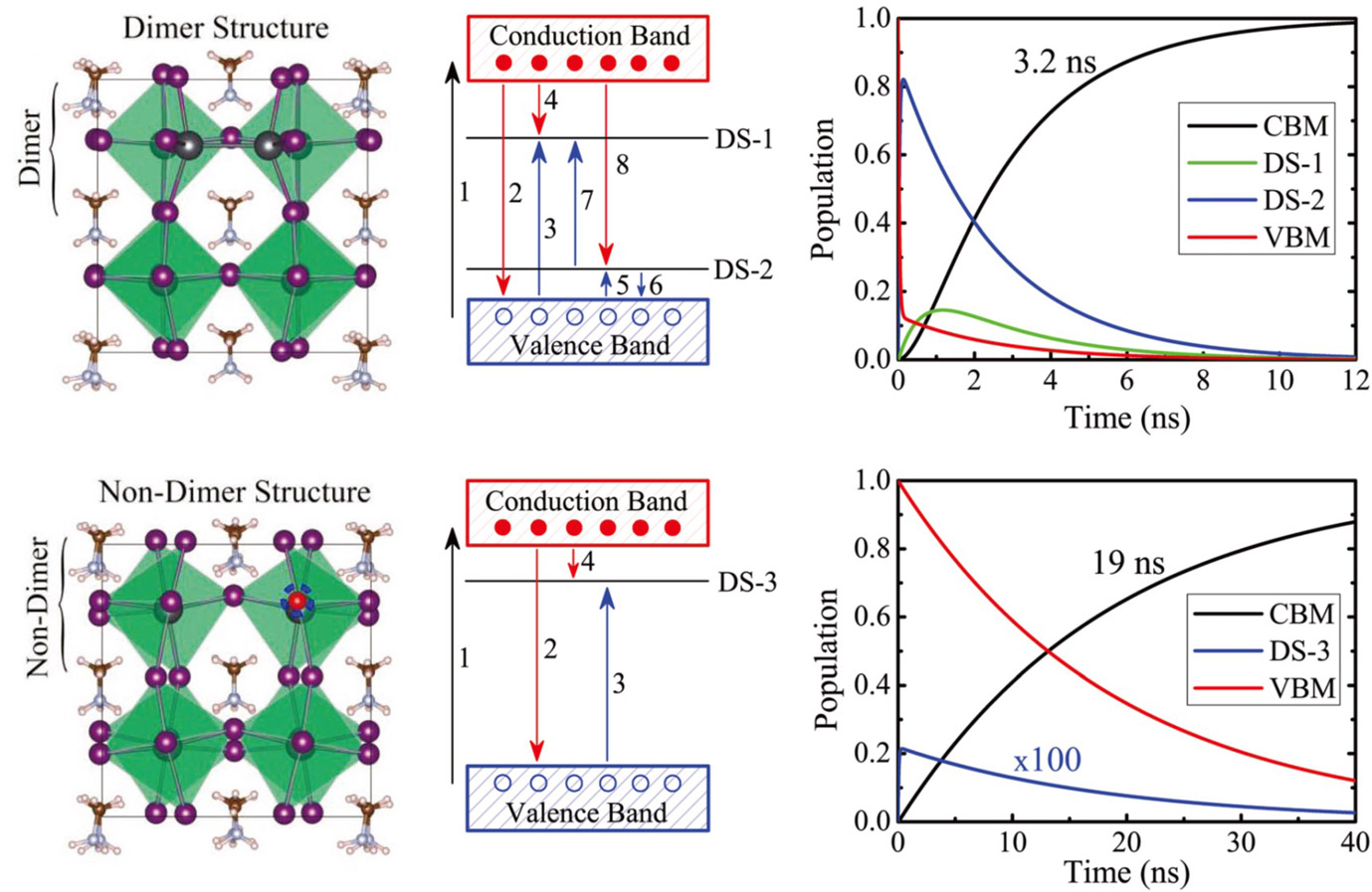
After a period of rapid, unprecedented development, the growth in the efficiency of perovskite solar cells has recently slowed. Further improvement of cell efficiency will rely on the in-depth understanding and delicate control of defect passivation. Here, the formation mechanism of iodine vacancies (VI), a typical deep defect in CH3NH3PbI3 (MAPbI3), is elucidated. The structural and electronic behaviors of VI are like those of a DX center, a kind of detrimental defect formed by large atomic displacement. Aided by the passivation mechanism of DX centers in tetrahedral semiconductors, it is found that the introduction of Br strengthens chemical bonds and prevents large atomic displacements during defect charging. It therefore reduces the defect states and diminishes electron–phonon coupling. Using time-domain density functional theory (DFT) combined with nonadiabatic molecular dynamics, it is found that the carrier lifetime can be enhanced from 3.2 ns in defective MAPbI3 to 19 ns in CH3NH3Pb(I0.96Br0.04)3. This work advances our understanding of how a small amount of Br doping improves the carrier dynamics and cell performance of MAPbI3. It may also provide a route to enhance the carrier lifetimes and efficiencies of perovskite solar cells by defect passivation.
For details, please refer to Advanced Materials 32, 1906115 (2020).
-
Defect tolerance in CH3NH3PbI3
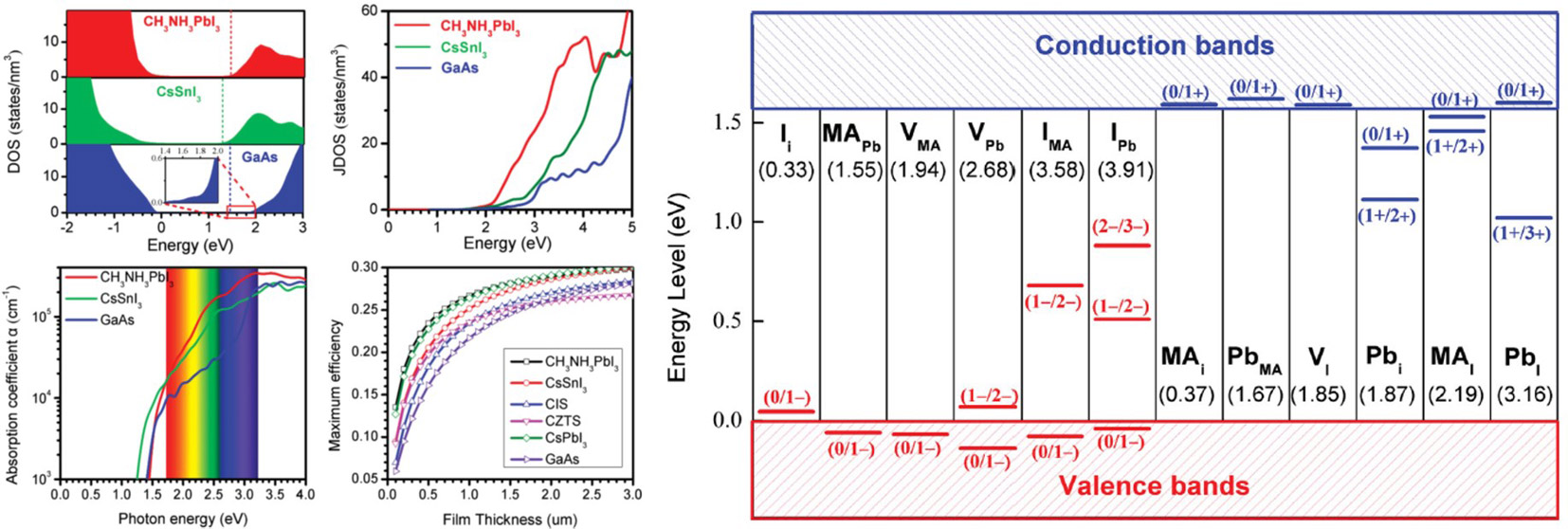
Thin-film solar cells based on CH3NH3PbI3 halide perovskites have recently shown remarkable performance. We show that dominant intrinsic defects in CH3NH3PbI3 create only shallow levels, which partially explain the long electron-hole diffusion length and high open-circuit voltage in solar cell. The unusual defect properties can be attributed to the strong Pb lone-pair s orbital and I p orbital antibonding coupling and the high ionicity of CH3NH3PbI3.
For details, please refer to Applied Physics Letters 104, 063903 (2014) (over 1300 citations); Advanced Materials 26, 4653 (2014) (over 1000 citations).
-
-
Materials Design
-
Symbolic Regression-derived Descriptor Accelerating Discovery of Catalysis
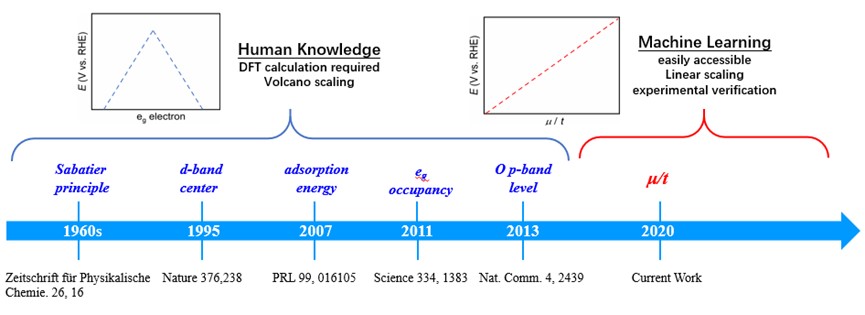
There has been a long-standing interest in the field of catalysis to identify descriptors. Conventional descriptors from human knowledge, with typical volcano scaling, have shown their influential impact in the field. For example, seminal work of $e_g$ occupancy as a descriptor [Science 334, 1383 (2011)] in oxide perovskite catalyst has stimulated subsequent works such as the descriptor of O $p$ band level [Nat. Comm. 4, 2439 (2013)] and the combined descriptors of $t_2g$, $e_g$ occupancies and $pd$ interaction [Nat. Comm. 11, 652 (2020)].
Descriptors are the concise relationships between structure (composition) and properties. We note that conventional descriptors ($t_2g$, $e_g$ occupancies, O $p$ band level and $pd$ interaction) are based on human knowledge of physics and chemistry, i.e. the interactions between the adsorbate and catalyst should be neither too strong nor too weak (Sabatier principle), leading to volcano scaling. Here, human-knowledge-based descriptors and volcano scaling haven been challenged by a machine learning approach.
We synthesized and characterized over thirty oxides (23 perovskites and 11 non-perovskites), which were then studied by the symbolic regression, an $interpretable$ and $glass\mbox{-}box$ machine learning approach. We derived an unprecedentedly simple descriptor, $\mu/t$, where $\mu$ and $t$ are the octahedral and tolerance factors, respectively. The performance of $\mu/t$ is comparable to conventional descriptor of $e_g$ occupancy. Since both $\mu$ and $t$ are the function of ionic radii only, such descriptor makes catalysts design refrain from DFT calculations and therefore much efficient and easy. The descriptor is then used to screen out four oxide perovskites with high oxygen evolution reaction (OER) activity among 3,545 candidates. Among them, Cs-containing oxide perovskites have never been reported in literature but successfully synthesized under the guidance of the new descriptor. The experimental part of this work was done by Prof. Yanfa Yan’s group in University of Toledo, USA.
For details, please refer to Nature Communications 11, 3513 (2020).
-
Design solar cell materials via coordination gene
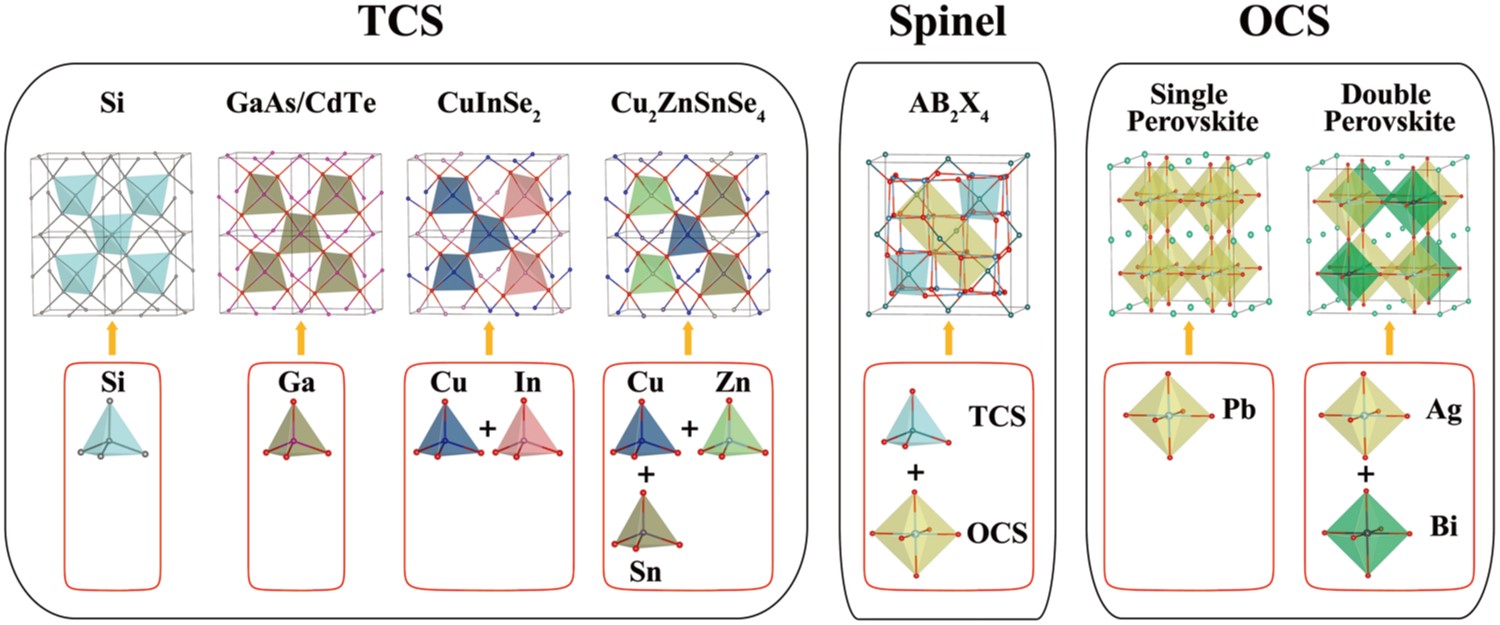
Tetrahedral coordination structures, e.g. crystalline Si, GaAs, CdTe, and octahedral coordination structures, e.g. perovskites, represent two classes of successful crystal structures hitherto for solar cell absorbers. Here, via first-principles calculations and crystal symmetry analysis, the two classes of semiconductors are shown exhibiting complementary properties in terms of bond covalency/ionicity, optical property, defect tolerance, and stability, which are correlated with their respective coordination number. Therefore, a spinel structure is proposed, which combines tetrahedral and octahedral coordination into a single crystal structure, as an alternative to perovskite and conventional semiconductors for potential photovoltaic applications. The case studies of a class of 105 spinel AB2X4 systems identify five spinel compounds HgAl2Se4, HgIn2S4, CdIn2Se4, HgSc2S4, and HgY2S4 as promising solar cell absorbers. In particular, HgAl2Se4 has suitable bandgap (1.36 eV by GW0 calculation), small direct–indirect bandgap difference (24 meV), appropriate carrier effective mass ($m_e = 0.08\,m_0$, and $m_h = 0.69\,m_0$), strong optical absorption, and high dynamic stability. This study suggests that crystal systems with mixed tetrahedral and octahedral coordination may open a viable route for emerging solar cell absorbers.
For details, please refer to Advanced Materials 31, 1806593 (2019).
-
Predict stable perovskites by machine learning
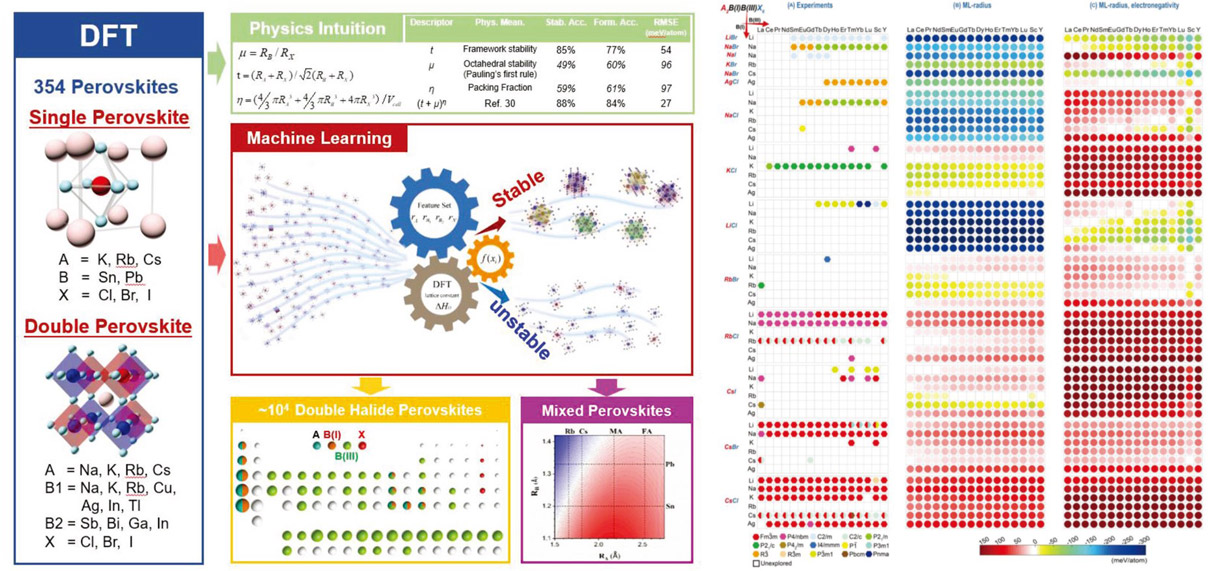
Formability and stability issues are of core importance and difficulty in current research and applications of perovskites. Nevertheless, over the past century, determination of the formability and stability of perovskites has relied on semiempirical models derived from physics intuition, such as the commonly used Goldschmidt tolerance factor, t. Here, through high-throughput density functional theory (DFT) calculations, a database containing the decomposition energies, considered to be closely related to the thermodynamic stability of 354 halide perovskite candidates, is established. To map the underlying relationship between the structure and chemistry features and the decomposition energies, a well-functioned machine learning (ML) model is trained over this theory-based database and further validated by experimental observations of perovskite formability (F1 score, 95.9%) of 246 A2B(I)B(III)X6 compounds that are not present in the training database; the model performs a lot better than empirical descriptors such as tolerance factor t (F1 score, 77.5%). This work demonstrates that the experimental engineering of stable perovskites by ML could solely rely on training data derived from high-throughput DFT computing, which is much more economical and efficient than experimental attempts at materials synthesis.
For details, please refer to Advanced Functional Materials 29, 1807280 (2019).
-
Propose new descriptor for perovskite stability

Stability is of central importance in current perovskite solar cell research and applications. Goldschmidt tolerance factor ($t$) recently provided qualitative guidance for experimentalists to engineer stable ABX3 perovskite by tuning effective ionic size with mixing cations or anions and for theorists to search emerging perovskites. Through first-principles calculations, we have calculated decomposition energies of 138 perovskite compounds of potential solar cell applications. Instead of $t$, we have found that $(\mu+t)\eta$, where $\mu$ and $\eta$ are the octahedral factor and the atomic packing fraction, respectively, demonstrates a remarkably linear correlation with thermodynamic stability. As a stability descriptor, $(\mu+t)\eta$ is able to predict the relative stability among any two perovskites with an accuracy of ∼90%. This trend is then used to predict decomposition energies of another 69 perovskites, and the results are in excellent agreement with first-principles calculations, indicating the generalization of the trend. This thermodynamic stability trend may help the efficient high-throughput search for emerging stable perovskites and precise control of chemical compositions for stabilizing current perovskites.
For details, please refer to Journal of the American Chemical Society 139 (42), 14905-14908 (2017).
-
-
Graphene Growth
-
Coming soon ...
-